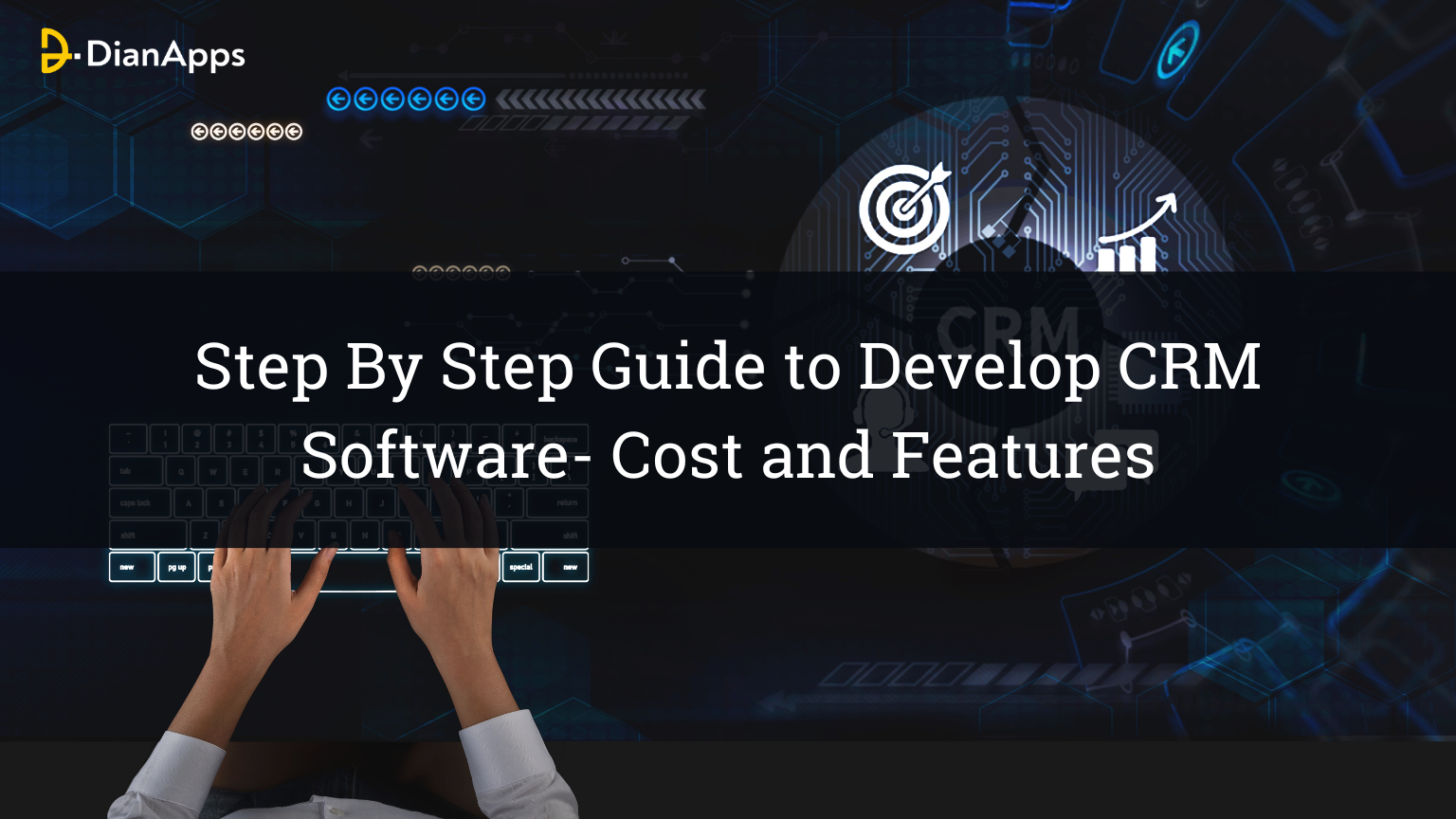Step By Step Guide to Develop CRM Software- Cost and Features
Software called a Customer Relationship Management (CRM) system is made to assist companies in managing their consumer relationships, streamlining operations, and increasing profitability.
CRM essentially offers a single platform that allows companies to track sales, store customer data, and handle customer support interactions. However, how precisely can a CRM support the expansion of a business?
CRM is the key to success as it enhances sales income by 29% and sales productivity by 34%, per a Salesforce analysis. This demonstrates how CRM may affect a company’s productivity and earnings.
A well-designed CRM system becomes a vital tool as businesses work to preserve solid relationships with their clients in a market that is becoming more and more competitive.
However, how can you start from scratch and develop a CRM solution that actually fits your company’s needs? To discover, let’s take a closer look at the detailed procedure of developing CRM software along with the development cost and features.
What is the Cost of CRM Software Development?
The cost of CRM software development varies on:
- Number of users
- Features and functionality
- Complexity
- Implementation costs
Based on these here are the estimated costs for CRM software development:
- RM software licenses: ₹1,500–₹15,000 per user per month
- Implementation fees: ₹1,00,000–₹5,00,000
- Integration with existing systems: ₹50,000–₹3,00,000
- Data migration: ₹20,000–₹1,00,000
A free plan to test out the essential functionality is provided by several CRM systems. Others, such as Pipedrive, charge $14 a month per user. However, the monthly cost of specialized CRM packages with cutting-edge capabilities might reach $5,000 per user.
What are The Features Needed To Build CRM Software?
1. Contact Management
This function, which forms the foundation of your CRM, lets you store and arrange client data in a single database. It should be simple for users to add, edit, and look up contact information. Consider including features allowing you to categorize and group contacts according to factors like past purchases or industry.
2. Sales Automation:
Automate repetitive duties like lead scoring, follow-up reminders, and sales pipeline management to streamline your sales processes. Consider this: How can we streamline our sales process to need less human labor? In addition to increasing productivity, sales automation raises the precision of sales reporting and projections.
3. Customer Support Management:
Give employees the resources they need to handle client communications and quickly address problems. Take knowledge bases, live chat, and ticketing systems into consideration. Support staff, including a customer service virtual assistant, should be empowered by this module to provide outstanding customer service, which will eventually increase client retention and satisfaction.
4. Analytics and Reporting:
Provide in-depth information about marketing initiatives, sales results, and consumer behavior. To emphasize important indicators that support your company’s objectives, personalize dashboards and reports. Well-informed decision-making and strategic planning are made possible by this data-driven approach.
5. Integration Features:
Verify that your CRM can easily interface with current systems, including e-commerce platforms, accounting software, and email platforms. Integration improves departmental cooperation and lessens data silos.
6. Mobile Access:
Having a mobile-friendly version of your CRM is crucial in today’s mobile-first society. Make sure users have mobile access to essential features so they can operate effectively from any location.
7. Compliance and Security:
Put strong security measures in place to safeguard private client information. Think about role-based access controls, user authentication, and encryption. Adherence to laws such as GDPR is also essential in order to stay out of trouble with the law.
Create a Minimum Viable Product (MVP) first, incorporating these essential elements. With this method, you may test the CRM with actual users and get their input for upcoming enhancements. As you go, keep improving the system to satisfy changing demands by iterating constantly depending on user input.
Steps To Create a CRM Software For Your Business
A CRM has a development life cycle, just like any other software, that is used to create a high-quality product quickly. This article will walk you through Syndicode’s bespoke CRM creation process, which may vary from developer to developer.
Here’s how to create CRM software from the ground up:
- Decide on a CRM type and make sure your goals are clear.
- Select the CRM development features and locate a development partner.
- Make a design for UI/UX.
- Make sure technical assistance is provided and release the CRM.
Let’s examine each of these actions in more depth.
1. Clearly define your objectives for CRM development.
There are several approaches to developing a CRM system, but you must establish your system’s objectives to prevent overstretching yourself. How may it increase your profitability and what particular advantages could it provide your company?
The following are typical goals that businesses set for their bespoke CRM development projects:
- Improving client happiness and experience by offering a deeper understanding of consumer preferences and behavior;
- Increasing revenue and sales through lead monitoring, sales process optimization, and more focused marketing and sales initiatives;
- Enhancing customer retention tactics through the identification of high-risk clients and churn causes;
- centralizing client data so that staff members from other departments may readily access it, hence enhancing internal communication and cooperation;
- Lead management and nurturing; automating repetitive processes, like data entry and follow-up reminders, to free up staff time for more strategic endeavors;
- Safeguarding client information and making sure data protection laws, like the GDPR, are followed
- Promoting cooperation and information exchange with distributors and partners.
You may select the best CRM type once your objectives for custom CRM development have been determined and prioritized.
CRM software types
There are three primary types based on the function of a CRM and its tools.
CRM Collaboration
By fostering an open atmosphere for data exchange, a collaborative CRM seeks to enhance communication and cooperation. For internal use or for external teams, such as partners, you create your own CRM. Typically, a collaborative platform has features for group conversations, file sharing, and activity streaming.
Analytical CRM
Analytical CRM tools are meant to help with planning. Analytical data, statistics, and insights are provided by such a platform. It should thus be able to gather, interpret, and display data in real time from a wide range of sources.
CRM for operations
Business process automation and simplification are the main goals of this kind of CRM. Its objective is to boost productivity. Processing leads, creating automated communications for clients via various channels, and sending follow-ups are all frequently aided by an operational platform.
2. Find a Development Partner
Finding a trustworthy software development company is the next step after figuring out how to create a CRM. You can choose between in-house development and outsourcing. Let’s talk about each of these options in brief.
Hiring outside experts to work on your CRM project who aren’t on your full-time staff is known as outsourcing. You may engage a committed team or individual freelancers based on your needs.
Outsourcing CRM development
By hiring experts to work for your company on a long-term basis and giving them the workspace and tools they need, you are engaging in in-house development. It frequently entails an extra tax burden.
In-house development model
We advise taking into account the following factors if you decide to outsource the development of your CRM. A successful and seamless partnership may be ensured by comparing a possible partner to this list.
- Specialty knowledge. The quicker the development process and the better the outcome, the more expertise the organization has in creating CRMs. Additionally, you may discover how the company’s work aligns with your goal by looking through their case studies.
- Reviews from clients. This is an additional method to assess how the possible partner approaches the creation of a bespoke CRM and whether their procedures fit your goals. Reviews might help you identify the company’s advantages and disadvantages and help you set more reasonable expectations. Examine evaluations on the business’s website and third-party sites like GoodFirms and Clutch.
- Time zone. You should be mindful of the scheduling discrepancies between you and your partner if you choose to outsource the development of the CRM software abroad. Any communication breakdowns will lengthen the time needed for development and raise the price.
- Proficiency in the language. The majority of European nations are desirable outsourcing partners due to their affordable costs and strong English proficiency. Though there may be a linguistic issue, India and Asia are often less expensive. To guarantee mutual understanding, we advise setting up a meeting with your possible spouse, either in person or virtually.
3. Design the CRM Software
Due to the variety of user groups and massive amounts of data to handle, developing a UI/UX design services for a bespoke CRM system has special duties and problems. Take into account the following to make sure your CRM interface promotes user productivity:
- Determine the various users’ roles and duties inside your CRM system;
- Make personas for users;
- Sensibly arrange information and features;
- To make navigating easier, group relevant features and data together;
- Establish a design framework to guarantee that the CRM’s components are consistent;
- Give consumers’ regularly accessed data priority;
- Give users the ability to customize the CRM to suit their needs;
- Include onboarding resources like user manuals, tooltips, and contextual assistance.
4. Delivery and Support
The software development procedure for custom CRM initiatives is often the same as that of regular projects. However, there are crucial factors to bear in mind as you proceed from planning and design to real coding:
- Make a thorough technical definition that describes the database architecture, data structures, technologies to be employed, and system architecture;
- Make plans to transfer data to the new CRM from the current systems;
- Consider scalability while designing the CRM system to accommodate future growth in both data and users.
- Create APIs and connections to facilitate easy integration with other tools and software;
- Make that the CRM system is accessible and responsive across a range of platforms, including tablets, smartphones, and desktop computers;
- To completely test the code and find and fix bugs, performance issues, and usability issues, adhere to the software testing lifecycle;
- Verify that the CRM system and the code abide by applicable laws, such as the GDPR;
- Provide documentation to help developers, administrators, and end users comprehend and make efficient use of the system;
- Organize the deployment process, taking into account user training, staging environments, and rollback protocols in case of problems during release;
- After the CRM system goes live, be prepared to handle any problems, bugs, and user concerns by offering post-launch assistance.
Wrapping Up
A top-notch CRM created from the ground up with your help may serve as the foundation of your company. Now that you understand how to make your own CRM, you can design a system that yields a minimum return of $2.5 for every dollar invested in its creation.
How can you create a CRM that will boost your company’s productivity? Clearly defining the goal of a CRM and its functions is essential. After that, a skilled tech partner can assist you in turning your concept into a functional product.
Our full-cycle custom CRM development services at DianApps include helping customers with market research, ideation, validation, and, of course, turning their concepts into reality.




